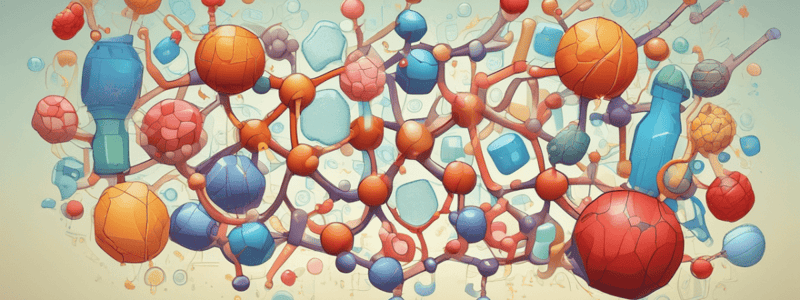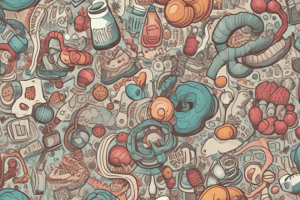Podcast
Questions and Answers
What is the molecular formula for monosaccharides?
What is the molecular formula for monosaccharides?
- C5H10O5
- C6H12O6 (correct)
- C6H6O12
- C10H20O10
Which process joins two monosaccharides to form a disaccharide?
Which process joins two monosaccharides to form a disaccharide?
- Combustion
- Oxidation
- Dehydration/condensation reaction (correct)
- Hydrolysis
Which carbon structure class does glucose belong to?
Which carbon structure class does glucose belong to?
- Hexose (correct)
- Tetrose
- Pentose
- Triose
What type of bond is formed between two monosaccharides in a disaccharide?
What type of bond is formed between two monosaccharides in a disaccharide?
What happens to hemoglobin when exposed to prolonged elevated blood sugar?
What happens to hemoglobin when exposed to prolonged elevated blood sugar?
Which type of fat has the maximum number of hydrogens bonded to its carbons?
Which type of fat has the maximum number of hydrogens bonded to its carbons?
What distinguishes cis-unsaturated fats from trans-unsaturated fats?
What distinguishes cis-unsaturated fats from trans-unsaturated fats?
Which type of unsaturated fat is associated with cardiovascular diseases?
Which type of unsaturated fat is associated with cardiovascular diseases?
Flashcards are hidden until you start studying
Study Notes
Carbohydrates
- Monosaccharides are the basic unit of carbohydrates, composed of carbon, hydrogen, and oxygen atoms in a 1:2:1 ratio.
- They have the general molecular formula (CH2O)n, where n can be 3, 5, or 6.
- Monosaccharides can be classified according to the number of carbon atoms in a molecule:
- Trioses (n = 3): e.g., glyceraldehyde
- Pentoses (n = 5): e.g., ribose and deoxyribose
- Hexoses (n = 6): e.g., fructose, glucose, and galactose
Disaccharides
- Disaccharides are formed when two monosaccharides react, releasing water and requiring energy.
- A glycosidic bond forms, holding the two monosaccharide units together.
Carbohydrates + Proteins
- Glycated Hemoglobin (HbA1C) is a form of hemoglobin that permanently binds to proteins like hemoglobin after prolonged exposure to elevated blood sugar.
- Normal Hemoglobin (Hb) transports four oxygen molecules by binding to four iron atoms inside each HEME Group.
Saturated vs. Unsaturated Fats
- Saturated fats have a maximum number of hydrogens bonded to the carbons, being "saturated" with hydrogen atoms.
- Unsaturated fats have carbon-carbon double bonds:
- Monounsaturated: a single double bond
- Polyunsaturated: multiple double bonds
Unsaturated Fats: Cis- and Trans-
- Cis-unsaturated fats:
- Usually occur naturally
- Hydrogens are on the same side of the double bond
- Create a kink, making them more likely to be liquids at room temperature
- Trans-unsaturated fats:
- Are manufactured
- Hydrogens are on opposite sides of the double bond
- Have no kinks, making them more likely to be solid at room temperature
- Are associated with cardiovascular diseases
Studying That Suits You
Use AI to generate personalized quizzes and flashcards to suit your learning preferences.




